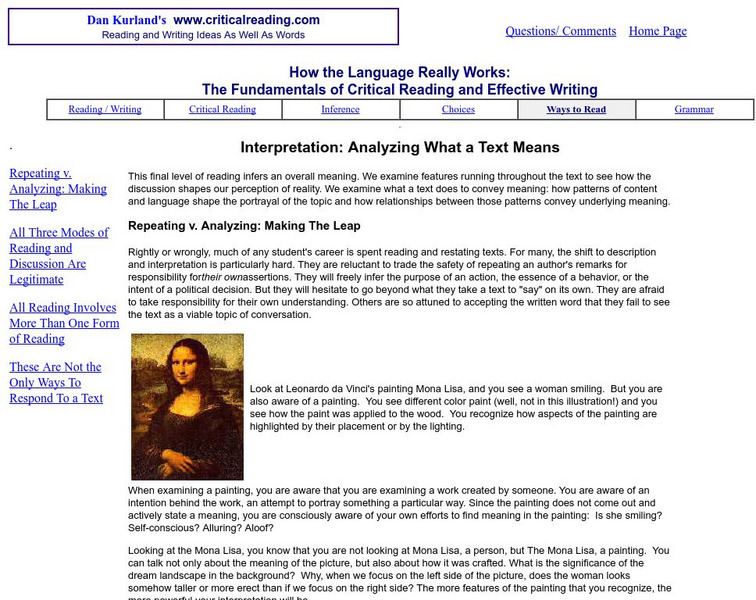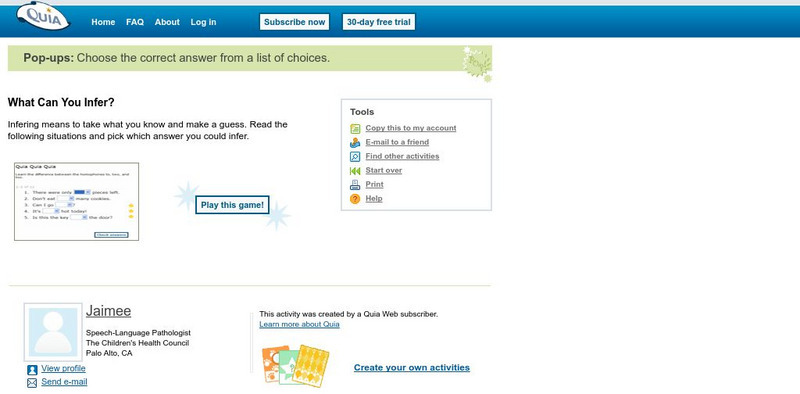CPALMS
Cpalms: "The Last Leaf": Making Inferences
This learning module has a series of screencast videos and practice exercises designed to teach students how to make inferences based on explicit and implicit information found within a text.
Read Works
Readworks: Reading Lesson 3: To Persuade
This instructional activity focuses on identifying text evidence that shows that the author's purpose is to persuade. Draw a conclusion about what the author is trying to persuade the reader to do or think. Text, worksheet, and chart are...
Better Lesson
Better Lesson: Using Word and Picture Clues to Make an Inference
First graders will use text evidence to make inferences about word and word phrase meanings in a text. Word and picture clues will be used to help students form inferences.
Folger Shakespeare Library
Juliet vs Laura: Analyzing Sonnet Structure in Romeo and Juliet
This lesson plan asks young scholars to access their knowledge of sonnet characteristics to analyze the shared sonnet of Romeo's and Juliet's first meeting to determine the extent to which Juliet meets the Petrarchan ideal.
Folger Shakespeare Library
A Guilty Gertrude: Performing Spoken and Silent Moments in Hamlet
This detailed lesson plan focuses on Hamlet's mother, Gertrude. Young scholars analyze, then perform six scenes which feature Gertrude, then determine where Gertrude's loyalties lie in each scene. This deepens students' understanding of...
Folger Shakespeare Library
Folger Shakespeare Library: Close Reading the Conspiracy in Julius Caesar, Act 2
In this lesson plan, students create a prompt book of Act 2, Scene 1. Each group of students will focus on a specific emphasis as they edit the scene.
Folger Shakespeare Library
Folger Shakespeare Library: Close Reading Shakespeare's Sonnets
This lesson plan teaches students to consider diction, syntax, literary devices, and rhetorical strategies in doing a close reading of Shakespeare's sonnets.
South Carolina Educational Television
Know It All: Summarizing Texts
Fifth graders will review what a summary is and complete a worksheet for practice. They will then write their own informational text and a peer will summarize.
South Carolina Educational Television
Know It All: Opinion Writing
Third graders will be able to form an opinion piece concerning one of their classmate's character traits and give reasons to support that opinion.
National Gallery of Art
National Gallery of Art: White Cloud: A Hero to His People
Students will learn about White Cloud, one of the chiefs of the Iowa people who attempted to raise money for his tribe after losing their land. Through discussion and research, students will write a journal entry from the standpoint of a...
Louisiana Department of Education
Louisiana Doe: Curriculum Hub: Ela Guidebooks: Teenage Brain: Review Claims About Social Media
Review claims made in "Teens: This Is How Social Media Affects Your Brain."
Louisiana Department of Education
Louisiana Doe: Louisiana Believes: Ela Guidebooks: Accountable Talk
This strategy helps students refine their understanding of texts to meet reading expectations, engage in group conversations to meet speaking and listening expectations, and prepare for writing about texts.
Joe Landsberger
Study Guides & Strategies: How to Read an Essay
Use this guide when reading an expository text or any type of essay, as it provides important questions you should ask yourself while you read. You can access this page in multiple languages from the English homepage.
McGraw Hill
Read: Does Technology Make Us Lazy?
Compare these two passages for some interesting ideas about how technology affects our lives. The questions that follow ask you to identify the main idea from either direct statement or inference.
Other
How the Language Really Works: Restatement
Choosing when to read for simple comprehension is the focus of this brief article.
Other
Critical Reading: How the Language Really Works: Interpretation
In this brief article, the author considers the ways that readers interpret text. An interesting comparison between reading and viewing a painting is worth a look.
Other
Speech Language Resources: Inference and Reading: A Guide for School Age Students
An explanation of inferences and how to make them. Examples and links to additional learning exercises are included.
Other
Ccss Literacy E Handbook: Informational Text: Use Details and Examples
A short explanation of how to use explicit details in an informational text to make inferences. Click on Model at the bottom right to see a model with examples.
Other
Ccss Literacy E Handbook: Informational Text: Reasons and Evidence in Text
A short explanation of using reasons and evidence as supporting details. Click the link to see a model of how to identify reasons and evidence in an informational text. Click on the Model button on the bottom right to see a model.
Other
Author Stream: Make an Inference
A slideshow with twelve slides giving information, examples, and practice exercises on making inferences
Other
Hickman Community Charter District: Informative Writing
Sample topics in informative writing for K-3rd grades and 4th-8th grades. CSS.ELA-Literacy.CCRA.W.2. CCSS.ELA-Literacy.WHST.6-8.9 Draw evidence from informational texts to support analysis, reflection, and research.
Annenberg Foundation
Annenberg Learner: Journey North: Reading Strategies: Make Inferences and Draw Conclusions
Learn how to go beyond the literal meaning of a text by using a list of guiding questions to make inferences and draw conclusions.
Quia
Quia: 5th Grade Drawing Conclusions
Read a short text and then choose an appropriate inference or conclusion in this five-question quiz.
Quia
Quia: What Can You Infer?
Choose the correct inference for each statement in this fifteen-question quiz.













